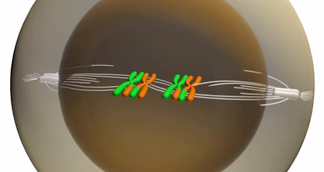
spindle fibers
Spindle
fibers form a protein structure that divides the genetic material in a cell.
The spindle is necessary to equally divide the chromosomes in a parental cell
into two daughter cells during both types of nuclear division: mitosis and
meiosis. During mitosis, the spindle fibers are called the mitotic spindle.
Meanwhile, during meiosis, the spindle fibers are referred to as the meiotic
spindle. At the beginning of nuclear division, two wheel-shaped protein
structures called centrioles position themselves at opposite ends of the cell
forming cell poles. Long protein fibers called microtubules extend from the
centrioles in all possible directions, forming what is called a spindle. Some
of the microtubules attach the poles to the chromosomes by connecting to
protein complexes called kinetochores. Kinetochores are protein formations that
develop on each chromosome around the centromere, which is a region located
near the middle of a chromosome. Other microtubules bind to the chromosome
arms or extend to the opposite end of the cell. During the cell division
phase called metaphase, the microtubules pull the chromosomes back and forth
until they align in a plane along the equator of the cell, which is called the
equatorial plane. The cell goes through an important checkpoint to ensure that
all of the chromosomes are attached to the spindle and ready to be divided
before it proceeds with division. Next, during anaphase, the chromosomes are
simultaneously separated and pulled by the spindle to opposite poles of the
cell.
Further Exploration
Concept Links for further exploration

















